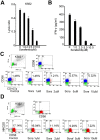Suppression of natural killer cells by sorafenib contributes to prometastatic effects in hepatocellular carcinoma
- PMID: 23409093
- PMCID: PMC3568028
- DOI: 10.1371/journal.pone.0055945
Suppression of natural killer cells by sorafenib contributes to prometastatic effects in hepatocellular carcinoma
Abstract
Sorafenib, a multi-tyrosine kinase inhibitor, is a standard treatment for advanced hepatocellular carcinoma (HCC). The present study was undertaken to determine whether the growth and metastasis of HCC were influenced in mice receiving sorafenib prior to implantation with tumors, and to investigate the in-vivo and in-vitro effect of sorafenib on natural killer (NK) cells. In sorafenib-pretreated BALB/c nu/nu mice and C57BL/6 mice, tumor growth was accelerated, mouse survival was decreased, and lung metastasis was increased. However, the depletion of NK1.1(+) cells in C57BL/6 mice eliminated sorafenib-mediated pro-metastatic effects. Sorafenib significantly reduced the number of NK cells and inhibited reactivity of NK cells against tumor cells, in both tumor-bearing and tumor-free C57BL/6 mice. Sorafenib down-regulated the stimulatory receptor CD69 in NK cells of tumor-bearing mice, but not in tumor-free mice, and inhibited proliferation of NK92-MI cells, which is associated with the blocking of the PI3K/AKT pathway, and inhibited cytotoxicity of NK cells in response to tumor targets, which was due to impaired ERK phosphorylation. These results suggest immunotherapeutic approaches activating NK cells may enhance the therapeutic efficacy of sorafenib in HCC patients.
Conflict of interest statement
Figures







Similar articles
-
Des-gamma-carboxy prothrombin antagonizes the effects of Sorafenib on human hepatocellular carcinoma through activation of the Raf/MEK/ERK and PI3K/Akt/mTOR signaling pathways.Oncotarget. 2016 Jun 14;7(24):36767-36782. doi: 10.18632/oncotarget.9168. Oncotarget. 2016. PMID: 27167344 Free PMC article.
-
TLR3 activation enhances antitumor effects of sorafenib in hepatocellular carcinoma by activating NK cell functions through ERK and NF-κB pathways.Sci Rep. 2024 Nov 2;14(1):26422. doi: 10.1038/s41598-024-78316-3. Sci Rep. 2024. PMID: 39488569 Free PMC article.
-
Single Agent and Synergistic Activity of the "First-in-Class" Dual PI3K/BRD4 Inhibitor SF1126 with Sorafenib in Hepatocellular Carcinoma.Mol Cancer Ther. 2016 Nov;15(11):2553-2562. doi: 10.1158/1535-7163.MCT-15-0976. Epub 2016 Aug 5. Mol Cancer Ther. 2016. PMID: 27496136 Free PMC article.
-
Complete response of hepatocellular carcinoma with right atrium and pulmonary metastases treated by combined treatments (a possible treatment effect of natural killer cell): A case report and literature review.Medicine (Baltimore). 2018 Oct;97(42):e12866. doi: 10.1097/MD.0000000000012866. Medicine (Baltimore). 2018. PMID: 30334999 Free PMC article. Review.
-
Combinational immune-cell therapy of natural killer cells and sorafenib for advanced hepatocellular carcinoma: a review.Cancer Cell Int. 2018 Sep 10;18:133. doi: 10.1186/s12935-018-0624-x. eCollection 2018. Cancer Cell Int. 2018. PMID: 30214375 Free PMC article. Review.
Cited by
-
Moderate swimming suppressed the growth and metastasis of the transplanted liver cancer in mice model: with reference to nervous system.Oncogene. 2016 Aug 4;35(31):4122-31. doi: 10.1038/onc.2015.484. Epub 2015 Dec 21. Oncogene. 2016. PMID: 26686088
-
Advancements in elucidating the mechanisms of Sorafenib resistance in hepatocellular carcinoma.Int J Surg. 2025 Apr 1;111(4):2990-3005. doi: 10.1097/JS9.0000000000002294. Int J Surg. 2025. PMID: 39992113 Free PMC article. Review.
-
Sorafenib in advanced hepatocellular carcinoma: current status and future perspectives.J Hepatocell Carcinoma. 2014 Jun 12;1:85-99. doi: 10.2147/JHC.S45040. eCollection 2014. J Hepatocell Carcinoma. 2014. PMID: 27508178 Free PMC article. Review.
-
Sorafenib plus memory-like natural killer cell immunochemotherapy boosts treatment response in liver cancer.BMC Cancer. 2024 Sep 30;24(1):1215. doi: 10.1186/s12885-024-12718-4. BMC Cancer. 2024. PMID: 39350084 Free PMC article.
-
Targeting angiogenesis for liver cancer: Past, present, and future.Genes Dis. 2020 Apr 7;7(3):328-335. doi: 10.1016/j.gendis.2020.03.010. eCollection 2020 Sep. Genes Dis. 2020. PMID: 32884987 Free PMC article. Review.
References
-
- Jemal A, Bray F (2011) Center MM, Ferlay J, Ward E, et al (2011) Global cancer statistics. CA Cancer J Clin 61: 69–90. - PubMed
-
- Clavien PA, Petrowsky H, DeOliveira ML, Graf R (2007) Strategies for safer liver surgery and partial liver transplantation. N Engl J Med 356: 1545–1559. - PubMed
-
- Carr BI (2004) Hepatocellular carcinoma: current management and future trends. Gastroenterology 127: S218–224. - PubMed
-
- Johnson P, Billingham L (2009) Sorafenib for liver cancer: the horizon broadens. Lancet Oncol 10: 4–5. - PubMed
-
- Palmer DH (2008) Sorafenib in advanced hepatocellular carcinoma. N Engl J Med 359: 2498; author reply 2498–2499. - PubMed
Publication types
MeSH terms
Substances
LinkOut - more resources
Full Text Sources
Other Literature Sources
Medical
Molecular Biology Databases
Research Materials
Miscellaneous

